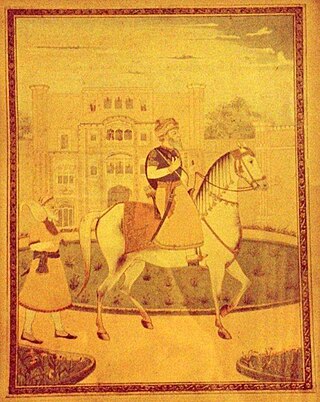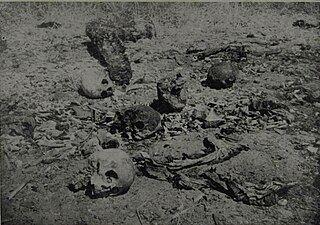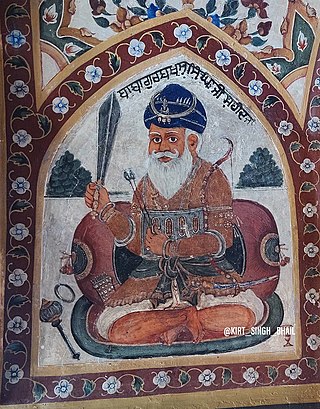
Sultan-ul-Qaum Sardar Jassa Singh Ahluwalia was a Sikh leader during the period of the Sikh Confederacy, being the Supreme Leader of the Dal Khalsa. He was also Misldar of the Ahluwalia Misl. This period was an interlude, lasting roughly from the time of the death of Banda Bahadur in 1716 to the founding of the Sikh Empire in 1801. He founded the Kapurthala State in 1772.

Vadda Ghalughara was the mass murder of unarmed Sikhs by the Afghan forces of the Durrani Empire during the years of Afghan influence in the Punjab region of the Indian subcontinent owing to the repeated incursions of Ahmad Shah Durrani in February 1762. It is distinguished from the Chhota Ghalughara. Mostly non-combatants were killed in the event, and an estimated that 10,000 to 50,000 Sikhs were killed on 5 February 1762.

The Afghan–Sikh Wars spanned from 1748 to 1837 in the Indian subcontinent, and saw multiple phases of fighting between the Durrani Empire and the Sikh Empire, mainly in and around Punjab region. The conflict's origins stemmed from the days of the Dal Khalsa, and continued after the Emirate of Kabul succeeded the Durrani Empire.
The Battle of Kup was fought on 5 February 1762, between the Afghan forces of Ahmad Shah Durrani and the Sikhs, under the command of Jassa Singh Ahluwalia and Charat Singh.Ahmad Shah Durrani and the Afghan forces reached Malerkotla, west of Sirhind.Different sources give various estimates on how many sikhs were present.According to Tom Landsford, nearly 30,000 Sikh men, women, children, and elderly laid encamped.According to Narendra Sinha, 40,000 Sikhs were present.According to Hari Ram Gupta, 50,000 Sikh soldiers laid encamped at Kup while 5,000 non combatants laid encamped at Pind Garma.Abdali's forces outnumbered the Sikhs in hand to hand combat and the Sikhs couldn't use their usual tactics of hit and run, but had to engage in battle while protecting the civilians at the same time.With surprise attack, the Sikhs threw a human shield around civilians as protection and fought the battle killing several thousand Afghans.Abdali was able to break the ring and carried out a full scale massacre of the Sikh civilians. Ahmad Shah's forces killed several thousand Sikhs, and the surviving Sikhs fled to Barnala. According to various different estimates, as many as 5,000 to 30,000 Sikh men, women, elderly and children were killed in what is known as the second Sikh holocaust.
The Battle of Sialkot took place on 12 November 1763, between the Durrani Empire, led by Jahan Khan, and the Sukerchakia Misl, led by Charat Singh, as part of the Afghan-Sikh wars which concluded with Sikh victory.

Ahmad Shah Durrani invaded the Indian subcontinent from the northwest eight times between 1748 and 1767. After the assassination of Nadir Shah, Ahmad Shah Durrani succeeded the throne of Afghanistan and started plundering wealth from nearby regions. His repeated incursions brought the Mughal empire to the brink of collapse and further dealt a major blow to Maratha dominions in the North at Panipat, creating a power vacuum. His objectives were met through the raids and caused political issues in India.
The Battle of Manupur was fought between the Mughal Empire and the Durrani Empire in March 1748 near Sirhind which ended in victory for the Mughals.

The Battle of Amritsar, also known as the Battle of Gohalwar, was fought between the Durrani Empire and Shaheedan Misl of the Dal Khalsa on 11 November 1757. Following the fourth invasion of Ahmad Shah Durrani, his army was attacked by Sikh bands under the command of Ala Singh and Baba Deep Singh. Following the attacks, Ahmad Shah desecrated the Sikh holy site known as the Shri Harmandir Sahib in Amritsar. The news of the desecration reached Baba Deep Singh who vowed to liberate the holy site from the Afghans. This resulted in a pitched battle being fought in the village of Gohalwar, near Amritsar. The battle resulted in Baba Deep Singh being killed. The exact result of the battle is disputed among historians.
The Battle of Mahilpur was fought between the Sikh Misls and Adina Beg Khan against the Durrani Empire in December 1757.Following the 4th invasion of Ahmad Shah Durrani,he would appoint Timur Shah as the viceroy of Punjab with Jahan Khan as his deputy.The Afghans would appoint Adina Beg Khan as the faujdar of the Jalandhar Doaba and exempting him from attending court at lahore, on the condition that Adina Beg pay revenue to the Afghan government.Soon a dispute regarding the payment of revenue occurred between Adina Beg and the Afghans.This dispute soon escalated which resulted in Jahan Khan sending an Afghan force to arrest Adina Beg.Adina Beg formed a military alliance with the Sikhs under the command of Jassa Singh Ahluwalia and Vadbhag Singh Sodhi.Adina Beg also gained the support of Sadiq Beg Khan,Khwaja Mirza Khan,and Raja Bhup Singh.Adina Beg along with the Sikh forces fought the Afghans at Mahilpur.The battle resulted in a victory for Adina Beg and the Sikhs and resulted in the entire Jalandhar Doaba being occupied and sacked by the Sikh forces.

Baba Gurbaksh Singh was a Sikh warrior from the 18th century who served under the Shaheedan Misl of the Sikh confederacy. Gurbaksh Singh along with 29 other Sikh warriors led a last stand against the Afghan and Baloch forces on December 1, 1764 at Amritsar. It was in this skirmish that Baba Gurbaksh Singh along with 29 other Sikhs were killed.
The Battle of Darbar Sahib was fought in 1764, during the Afghan-Sikh Wars, between the Shaheedan Misl of the Sikhs and the Durrani Empire of Ahmad Shah Abdali aided by the Khanate of Kalat.

The Siege of Multan started in January 1780 and ended on 18 February 1780, it was the result Timur Shah Durrani's reconquest campaigns of Multan after it had been taken in 1772. This siege saw the Afghans successfully re-capture Multan after taking Rohtas months prior.
The Battle of Jandiala took place in December 1764 between the Durrani Empire and the Sikhs Misls during Ahmad Shah Abdali's seventh campaign into India. Ahmad Shah Abdali and his army marched towards Jandiala and as soon as they reached near the town, the Sikhs opposed them and a battle took place where the Afghans were defeated and the Afghan commander Rahim Khan Bakhshi was killed.
The Battle of Batala took place on December 1764 as part of the Afghan-Sikh Wars between the Durrani Empire and the Sikhs Misls. Ahmad Shah Durrani and his force marched towards Batala after their defeat at Jandiala and as soon as they reached Batala, the Sikhs opposed them and a battle took place where the Durranis were defeated and Afghan commander Sarbuland Khan was wounded.
The Battle of Amritsar took place on 17 January 1767 between the Durranis and the Sikh Misls during Ahmad Shah Abdali's eighth campaign into India. Durrani commander Jahan Khan marched to the neighborhood of Chak where he was met by the Sikhs who became aware of Khan's movements. A battle ensued, resulting in the defeat of Afghans with between 5,000 to 6,000 casualties.
The Battle of Qarawal was fought Between the Sikhs under the command of Charat Singh against the Afghan forces lead by Ahmad Shah Abdali and his Kalat ally Nasir Khan.The battle resulted in a victory for the Afghan forces and forced the Sikhs to withdraw to Amritsar.
The Battle on the Beas took place in March 1765, between the Durranis and the Sikh Misls as part of the Afghan-Sikh wars during Ahmad Shah Abdali's return home. The battle which took place on the seventh day of the ongoing harassment by the Sikhs, ended without any conclusion.
The Battle on the Sutlej took place in March 1765, between the Durranis and the Sikh Misls as part of the Afghan-Sikh wars during Ahmad Shah Abdali's return home. The pitched battle ended indecisively.
The battle of the Jullundur Doab took place in 1765, between the Durranis and the Sikh Misls as part of the Afghan-Sikh wars which ended with Afghan victory as the Sikhs failed to seize any plunder.
The Battle of Pipli Sahib also known as Battle of Amritsar was a battle fought by the Sikh Misls and the Durrani Empire. This battle is also referred to as Badla Singhan Da and was fought after the great Sikh holocaust.






